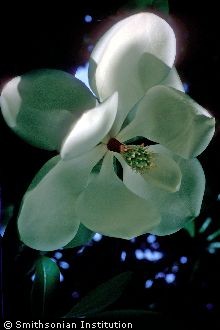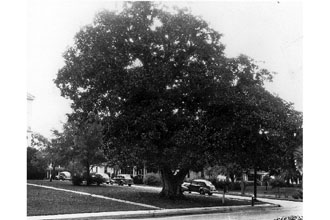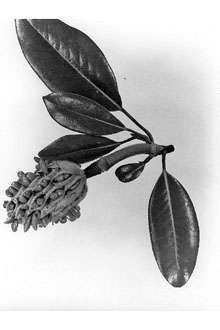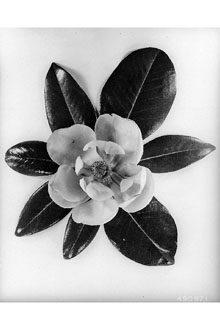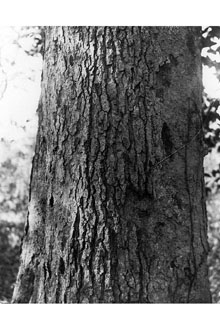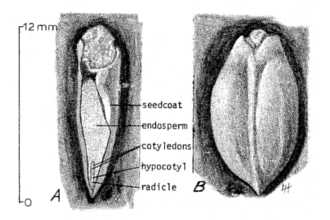Southern Magnolia
Scientific Name: Magnolia grandiflora L.
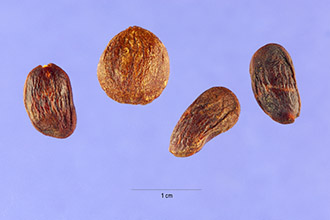
| General Information | |
|---|---|
| Usda Symbol | MAGR4 |
| Group | Dicot |
| Life Cycle | Perennial |
| Growth Habits | Tree |
| Native Locations | MAGR4 |
Plant Guide
Alternate Names
Common Names: evergreen magnolia; bull-bay; big-laurel
Description
General: Magnolias are one of the oldest tree species in the world (USNA, 2006). Southern magnolia is a flowering, woody evergreen tree, with a straight, light brown/gray-brown trunk with scales that are pressed close together. It has a conical crown that grows approximately 50–90 ft tall and 2–4 ft in diameter; and it may live 80–120 years (Maisenhelder, 1970; MFC, 2007). Some southern magnolias may grow as wide as tall (Dirr, 1998). Sweetbay magnolia (Magnolia virginiana) is similar in appearance, but has a smaller circumference and shorter height. Southern magnolia has moderately stout twigs that have brown wooly hairs. The stems have vertical lenticals and shield-shaped leaf scars. The pith is large, white, and blocky in appearance. The 5–8 in (13–20 cm) long, 2–3 in (5–8 cm) leaves are simple, alternate, and oval to elliptical. They are very thick and leathery, without teeth, and have a smooth, shiny surface above and a fuzzy, rusty color below. The leaves have pinnate venation and the margins of the leaves are smooth. The leaves can persist on the tree for approximately two years (MFC, 2007). The terminal flower bud is ¾–1 ¼ in (2–3 cm) long, is brown and pubescent, and tapers at the apex. The lateral/axillary bud is small (¼ in) and is slightly shrouded in hair. The tree flowers from late spring to fall; producing 6–8 in (15–20 cm) wide fragrant, showy, white, monoecious flowers (having male and female reproductive organs on same plant) on stout, hairy stalks. The flowers may have 6–15 petals. The fruit is an aggregate of dry, cylindrical, hairy, 3–5 in long (8–13 cm) carpels that turn red/red-brown with age. Each follicle contains one ½ in (1.3 cm) long bright red seed. The slightly flattened seed remains attached to the open pod by a thin, elastic thread. The roots are typical of magnolias and are rope-like, and unbranched (USNA, 2006). The roots can extend up to four times the canopy width (Gilman and Watson, 1994). Southern magnolia can be sometimes confused in appearance with the great laurel (Rhododendron maximum). Distribution: Magnolias once made up a large part of North Temperate forest trees before the last glacial period (Maisenhelder, 1970). Southern magnolia primarily grows in the southeastern US and the Atlantic and Gulf Coastal Plain in USDA Hardiness Zone 6–10 (Dirr, 1998). Southern magnolia is native from Maryland south to Florida and west to Texas. Cold-hardy cultivars can be grown as far north as southern Ohio, northern New Jersey, and Long Island. It is also grown on the west coast from Washington State south to California. For current distribution, please consult the Plant Profile page for this species on the PLANTS Web site. Habitat: It is listed in most states as a USDA facultative plant, meaning that it can occur equally often in both wetlands and non-wetlands. It often occurs in moist woodlands, hardwood hammocks, bottomlands, and in alluvium and outwashes from uplands; but may also grow on middle slopes (Maisenhelder, 1970). In contrast, sweetbay magnolia (Magnolia virginiana) is similar in appearance but its distribution extends farther north and it is designated as a facultative wetland (FACW) plant which means it usually occurs in wetlands. It does not occur in pure stands but grows intermixed with other hardwood species, growing singly or in small groups (Maisenhelder, 1970; Elias, 1980). It can often be found growing with sweetgum, blackgum, yellow-poplar, oaks, white ash, hickories, red maple, sweetbay magnolia, and American and winged elms (Maisenhelder, 1970).
Adaptation
Magnolia spp. are native to Southeast Asia, eastern North America, South and Central America, and the Caribbean (Knox et al. 2013). Approximately half of the 80 species of magnolia native to the eastern US and Southeast Asia are in cultivation (USNA, 2006). It grows in fine–medium textured soil with a pH of 4.5–6.5 (Hodges et al., 2010). It can survive in shade but has low drought tolerance. It does not survive in flooded conditions but can tolerate high moisture levels, aerosol salt, and has good tolerance of soil salinity (Maisenhelder, 1970; Wade, 2012; Gilman and Watson, 1994). Natural Resources Conservation Service Plant Guide
Uses
Timber/wood: Southern magnolia is the hardest and heaviest of the magnolia species most commonly harvested in the US. Its wood is hard, heavy, even textured, and similar to yellow poplar in color and properties, but it browns when exposed to air (Elias, 1980). Its wood color is light, with white sapwood and light to dark brown heartwood. It is highly resistant to shock, will not shrink, and holds nails well (Maisenhelder, 1970). It is used for furniture, cabinets, paneling, veneer, boxes, and crates (Maisenhelder, 1970; Hodges et al., 2010). Urban forestry/ornamental/shade: Southern magnolia is a very popular ornamental tree that is used extensively in the south. It is resistant to damage by sulfur dioxide and can be used as a screen or hedge in urban and suburban areas (Hodges et al., 2010; Dirr, 1998; Gilman and Watson, 2014). Southern magnolia is promoted as a hurricane/storm resistant tree in urban areas, right-of-ways, parks, and yards and as an alternative to the once-popular Bradford pair (Pyrus calleryana) and red and silver maples (Acer rubrum; A. saccharinum) which tend to break or topple easily (Brodbeck, 2015). Southern magnolia is one of the most wind-resistant trees in the southeastern Coastal Plain and was one of the best survivors of Hurricane Erin and Opal in 1995 (Duryea et al., 2007). And while some trees readily lose limbs and leaves during hurricanes to increase wind-resistance and survival, southern magnolia has a high survival rate during hurricanes without having a high rate of branch-loss or defoliation relative to other species. Nevertheless, magnolia used in an urban setting also has its limitations. Although magnolia’s individual leaves are large and persistent, its overall leaf surface area is relatively low, thus it does not provide substantial stormwater runoff reduction benefits (McPherson, 2003). A study by Nowak et al., (1990) also finds that the slower growth of the southern magnolia may make it more susceptible to vandalism and mortality in urban planting when compared to alternative faster growing trees such as black locust (Robinia pseudoacacia) and the London plane trees (Platanus x hispanica). The authors suggest that in urban contexts, mortality rates may be reduced by increasing the growth rate of new plantings through proper irrigation and fertilization, and by reducing competition and minimizing pruning. Lastly, in spite of its widespread use in urban, commercial, and municipal plantings, southern magnolia has been noted for its ability to occasionally displace curbs and sidewalks (Burger and Prager, 2008). Carbon Sequestration: As a potential residential or commercial shade tree, southern magnolia can provide significant energy savings for a home or office while helping to reduce carbon emissions. A cost-benefit study by McPherson (2003) found that 85% of total benefits provided by southern magnolia were due to energy savings. However, in the same study, magnolia provided much less benefit in terms of carbon dioxide (CO2) reductions due mainly to its relative slower growth rate and smaller tree size. In the Coastal Plain the southern magnolia can store 17,800 lb/tree per year (USFS, 2014). Wildlife: Seeds are eaten by squirrel, opossum, quail, turkey, mice, and chipmunks (Hodges et al., 2010; Elias, 1980). Seeds are high in fat and are a good energy source for migratory birds (USNA, 2006). They are eaten by eastern kingbirds, mockingbirds, robins, wood thrushes, and red-eyed vireos (Arnold Arboretum, 2011). Pollinators, especially beetles, are attracted to the pollen that is high in protein. Other Uses: A variety of extracts have been taken from leaves, fruits, bark, and wood for pharmaceutical applications (Hodges et al., 2010). The thick, waxy, long-lasting cut leaves are very aesthetically pleasing, and can be used in holiday flower arrangements.
Ethnobotany
The Choctaw Indians used a decoction of the bark of southern magnolia as a skin wash for heat, itching, and sores as well as in a steambath for dropsy (Taylor, 1940).
Status
Weedy or Invasive: There are no known problems with magnolias becoming weedy. Please consult with your local NRCS Field Office, Cooperative Extension Service office, state natural resource, or state agriculture department regarding its status and use. Please consult the PLANTS Web site (http://plants.usda.gov/) and your State Department of Natural Resources for this plant’s current status (e.g., threatened or endangered species, state noxious status, and wetland indicator values).
Planting Guidelines
Generally, magnolias are moderately fast-growing trees that are easy to grow. It may be propagated through bare root, container, stem cuttings, and grafts. Southern magnolia can be grown in a container and transplanted into field in late winter/early spring, in full sun or part-shade, in slightly acid, well-drained soils, and covered with a mulch to moderate soil temperature and moisture (Dirr, 1998; USNA, 2006). In the Southeast, container plants can be successfully transplanted throughout the year, and burlapped trees are transplanted from August to October (Wade, 2012). Trees that are 2–4 ft tall are easier to transplant than larger specimens (MFC, 2007). Southern magnolia should be planted 2 in. (5cm) above the surrounding soil to encourage roots to grow straight downwards. The roots respond to planting depth, so if the roots are planted too deep, they will grow towards the soil surface or laterally, and few roots will grow straight downwards. This may create a tree that is less stable in the landscape and more prone to toppling (Gilman, 2014). It will take approximately 4 years to develop an established root system (Wade, 2012). Water and apply 3–5 inches of mulch around the base of the plant to
Management
Container-grown plants should be transplanted in spring or fall, mulched, fertilized at planting, and well-watered. A study by Hensley et al. (1988) did not find a significant difference in growth measurements from fertilizer placement when placed at the bottom of the planting hole, mixed with backfill, or when applied to the surface of southern magnolia transplants. They also observed that a combination of spring planting, mulching, and fertilization resulted in significant growth in stem diameter. Applying ½ lb of 10-10-10 fertilizer at the base of the tree in March, May, and July during the first year of establishment will accelerate growth (Wade, 2012). Avoid fertilizing the tree during its slowest time of growth in fall and winter. Continued watering and mulching is required for successful establishment, and many projects have failed due to desiccation (MFC, 2007). Mulched plants of southern magnolia may be shorter at the end of the first year of growth than non-mulched plants, however after approximately 2 years of growth, mulched plants will have grown significantly larger than non-mulched plants (Hensley, 1988). Generally, southern magnolia does not require much pruning to develop a strong structure. If left unpruned, the tree limbs can reach the ground (MFC, 2007). Pruning should be done during the growing season, after blooming, as the tree does not heal well during dormancy (NPIN, 2013). Growing the plant against southern facing walls or as espaliers can help initiate blooms in more northern climates (Bir, 1992). As a landscape plant it is somewhat messy, and will shed its old leaves in spring, and its seedpods in late summer. These leaves can be raked under the tree and used as mulch. If there is evidence of leaf spot on the fallen leaves, those leaves should be raked up and disposed (Gilman and Watson, 1994). Few plants will be able to grow in the magnolia’s dense shade, persistent leaf residue, and among its shallow roots so it should be planted alone and treated as a specimen plant. It is well-suited for planting near ponds or in stream borders (Bir, 1992). Southern magnolia has coppice potential, which means the canopy of the plant may be fully removed (Hodges et al., 2010). Due to its very wide root system, it will undergo significant damage and will likely die if relocated during construction projects (Gilman and Watson, 1994).
Pests and Potential Problems
Magnolias do not tend to attract pests, however when outbreaks occur, they may result in significant economic or aesthetic loss (Knox et al. 2013). There are some reports of tulip-poplar weevil damage, leaf spots on young leaves, and the magnolia borer can girdle the trunk of young nursery stock (Dirr, 1998; Gilman and Watson, 1994). Magnolia serpentine leafminer moth damage can effect plants throughout northeastern states (Knox et al., 2013).Twigs and leaves may occasionally be heavily infested with scales that will not harm the growth of the plant, but may negatively affect its appearance (Gilman and Watson, 1994). Southern magnolia may have occasional or light feeding damage from Japanese beetles (Held, 2004). Despite these potential problems, Magnolia spp. contain antimicrobial, insecticidal, and nematicidal properties that help to reduce potential threats from pests and diseases (Knox et al., 2013).
Environmental Concerns
Concerns
Concerns
There is little chance of this plant becoming invasive. Nevertheless, few plants will be able to grow in the dense shade and heavy leaf residue underneath the tree. The chipped mulch of southern magnolia contains allelochemicals that can interfere with the establishment and growth of certain crops like lettuce (Rathinasabapathi et al., 2005).
Seeds and Plant Production
Plant Production
Plant Production
Magnolias are often pollinated by beetles. There is wide variation in bloom times and flower set between cultivars. In the case of previously planted trees, seed production may take 10–20 years depending on growth conditions (Dirr, 1998). After initial seed set, the tree can produce abundant seed crops every year. Under forested conditions, the initiation of seed production is delayed until approximately 25 years (Maisenhelder, 1970). Cones may be collected and dried in paper bags until seeds emerge. Seeds require 3–6 months of cold stratification at 32–41°F (Dirr, 1998). Excessive heating or drying can damage seeds. Seed may be soaked at room temperature for a week to speed the stratification process (Bir, 1992). Embryo dormancy is variable, so seed may not germinate the first year. Germination rate of southern magnolia seed is approximately 50% (Maisenhelder, 1970). Young cuttings planted in sand or perlite mixes with excellent drainage begin rooting after 6–10 weeks. Grafting and budding may also be used for propagation. Seed dispersal in natural communities may occur through birds, mammals, heavy rains, and winds (Maisenhelder, 1970). Cultivars, Improved, and Selected Materials (and area of origin) There are many cultivars of southern magnolia developed with different heights, growth habits, bloom times, bloom abundance, and cold tolerance. Nursery growers tend to propagate this plant through vegetative methods, and the seedlings can take up to 10 years or more to flower (Wade, 2012). Two of the more popular cold tolerant cultivars on the market are ‘Bracken’s Brown Beauty” (originates from SC) and ‘Edith Bogue’ (originates from NJ). ‘Bracken’s Brown Beauty’ is a cultivar highly prized for its brown, tomentose (short-haired) lower leaf surface (Williams et al., 2002). ‘Edith Bogue’ is a broad-spreading variety, with branches that will not break under snow accumulation. It is reported to bloom in 2–3 years (Gilman and Watson, 1994). The plant material originates in Montclair, NJ but can be grown as far away as the Pacific Northwest. There is a long-lived clone of ‘Edith Bogue’ in the Morris Arboretum in Philadelphia, PA (Dirr, 1998). Consult with your local land grant university, local extension or local USDA NRCS office for recommendations on adapted cultivars for use in your area.
Literature Cited
Arnold Arboretum, 2011, Fruits of autumn, Arnold arboretum seasonal guide, The Arnold Arboretum of Harvard University, Boston, MA, Bir, R, E, 1992, Growing and propagating showy native woody plants, Univ, Use soil moisture sensors to measure the soil moisture of Southern Magnolia., of N, Carol, Press, Chapel Hill, NC, Brodbeck, B, 2015, Smart growth in urban forestry; hurricane resistant trees, Urban & Community Forestry, Alabama Coop, Ext, Auburn Univ, Burger, D,W,, and T,E, Prager, 2008, Deep-rooted trees for urban environments: selection and propagation, Arboric, Urb, For, 34(3):184–190, Dirr, M,A, 1998, Magnolia virginiana, Stipes Publishing, Champaign, Illinois, Duryea, M, L,, E, Kampf, and R, C, Littell, 2007, Hurricanes and the urban forest: I, effects on southeastern United States Coastal Plain tree species, Arboric, Urb, For, 33(2):83, http://hort,ifas,ufl,edu/treesandhurricanes/documents/pdf/EffectsOnSEUSCoastalPlainTreeSpecies,pdf (accessed 02 Mar, 2015), Gilman, E,F, 2014, Roots responding to planting depth, UF IFAS Extension, Univ, of FL, Gainesville, FL, http://hort,ufl,edu/woody/root-coming-to-top-more,shtml (accessed 17 Feb, 2015), Gilman, E,F,, and D,G, Watson, 1994, Magnolia grandiflora: southern magnolia, Pub, #ST-371, USDA US Forest Service Factsheet, UF IFAS Extension, Univ, of FL, Gainesville, FL, http://hort,ifas,ufl,edu/database/documents/pdf/tree_fact_sheets/maggraa,pdf (accessed 19 Feb, 2015), Held, D,W, 2004, Relative susceptibility of woody landscape plants to Japanese beetle (Coleoptera: Scarabaeidae), J, Arboric, 30(6):328–335, Hensley, D,L,, R,E, McNiel, and R, Sundheim, 1988, Management influences on growth of transplanted Magnolia grandiflora, J, Arboric, 14(8):204–207, Hodges, J,D,, D,L, Evans, L,W, Garnett, A, Londo, and L, McReynolds, 2010, Mississippi trees, Miss, State Univ, Ext, Service, Miss, Forestry Commission, Jackson, Mississippi, http://www,fwrc,msstate,edu/pubs/ms_trees,pdf (accessed 17 Feb, 2015), Knox, G,W,, W,E, Klingeman III, A, Fulcher, M, Paret, 2013, Insect and nematode pests of Magnolia species in the southeastern United States, Issue 94, Univ, of Tenn, Knoxville, TN, http://plantsciences,utk,edu/pdf/Knox_etal-Insects_Nematodes_Magnolia-94_2013,pdf (accessed 27 Feb, 2015), Maisenhelder, L,C, 1970, Magnolia: (Magnolia grandiflora and Magnolia virginiana), American Woods FS–245, USDA Forest Service, McPherson, E,G, 2003, A benefit-cost analysis of ten street tree species in Modesto, California, U,S, J, Arboric, 29:1–8, Mississippi Forest Commission (MFC), 2007, The southern magnolia, MFC Publication #38, Jackson, MS, Nowak, D, J,, J, R, McBride, and R, A, Beatty, 1990, Newly planted street tree growth and mortality, J, Arboric, 16(5):124–129, NPIN (Native Plant Information Network), 2013, Lady Bird Johnson Wildflower Center, The Univ, of Texas at Austin, Rathinasabapathi, B,, J, Ferguson, and M, Gal, 2005, Evaluation of allelopathic potential of wood chips for weed suppression in horticultural production systems, HortSci, 40(3):711–713, Taylor, L,A, 1940, Plants used as curatives by certain southeastern tribes, Botanical Museum of Harvard Univ, Cambridge, MA, USFS, 2014, Tree carbon calculator, Forest Service Tools, Climate Change Resource Center, USDA-Forest Service http://www,fs,fed,us/ccrc/topics/urban-forests/ctcc/ USNA (United States National Arboretum), 2006, Magnolia questions and answers, National Arboretum, Washington, D,C, Williamson, J,, D, Shaughnessy, B, Polomski, 2014, Magnolia, Pub# HGIC 1015, Clemson Univ, Coop, Ext, Clemson, SC, Wade, G,L, 2012, Growing southern magnolia, Circular 974, The Univ, of GA Coop, Ext, Athens, GA, Williams, J,D,, J,L, Sibley, C,H, Gilliam, and G, Creech, 2002, Evaluations of Magnolia grandiflora selections in South-Central Alabama, U,S, J, Arboric, 28(5):224–228, Citation Sheahan, C,M, 2015, Plant guide for southern magnolia (Magnolia grandiflora), USDA-Natural Resources Conservation Service, Cape May Plant Materials Center, Cape May, NJ, Published 09/2015 Edited: September2015 rg For more information about this and other plants, please contact your local NRCS field office or
Conservation
District at http://www.nrcs.usda.gov/ and visit the PLANTS Web site at http://plants.usda.gov/ or the Plant Materials Program Web site: http://plant-materials.nrcs.usda.gov. PLANTS is not responsible for the content or availability of other Web sites.
Plant Traits
Growth Requirements
| Temperature, Minimum (°F) | 7 |
|---|---|
| Adapted to Coarse Textured Soils | No |
| Adapted to Fine Textured Soils | Yes |
| Adapted to Medium Textured Soils | Yes |
| Anaerobic Tolerance | None |
| CaCO3 Tolerance | Low |
| Cold Stratification Required | Yes |
| Drought Tolerance | Low |
| Fertility Requirement | Low |
| Fire Tolerance | Low |
| Frost Free Days, Minimum | 220 |
| Hedge Tolerance | None |
| Moisture Use | High |
| pH, Maximum | 6.5 |
| pH, Minimum | 4.5 |
| Planting Density per Acre, Maxim | 800 |
| Planting Density per Acre, Minim | 300 |
| Precipitation, Maximum | 60 |
| Precipitation, Minimum | 35 |
| Root Depth, Minimum (inches) | 42 |
| Salinity Tolerance | Medium |
| Shade Tolerance | Tolerant |
Morphology/Physiology
| Bloat | None |
|---|---|
| Toxicity | None |
| Resprout Ability | Yes |
| Shape and Orientation | Rounded |
| Active Growth Period | Spring and Summer |
| C:N Ratio | High |
| Coppice Potential | No |
| Fall Conspicuous | Yes |
| Fire Resistant | Yes |
| Flower Color | White |
| Flower Conspicuous | Yes |
| Foliage Color | Green |
| Foliage Porosity Summer | Dense |
| Foliage Porosity Winter | Dense |
| Foliage Texture | Coarse |
| Fruit/Seed Conspicuous | Yes |
| Nitrogen Fixation | None |
| Low Growing Grass | No |
| Lifespan | Long |
| Leaf Retention | Yes |
| Known Allelopath | No |
| Height, Mature (feet) | 100.0 |
| Height at 20 Years, Maximum (fee | 40 |
| Growth Rate | Moderate |
| Growth Form | Single Stem |
| Fruit/Seed Color | Red |
Reproduction
| Vegetative Spread Rate | None |
|---|---|
| Small Grain | No |
| Seedling Vigor | High |
| Seed Spread Rate | Slow |
| Fruit/Seed Period End | Summer |
| Seed per Pound | 6400 |
| Propagated by Tubers | No |
| Propagated by Sprigs | No |
| Propagated by Sod | No |
| Propagated by Seed | Yes |
| Propagated by Corm | No |
| Propagated by Container | Yes |
| Propagated by Bulb | No |
| Propagated by Bare Root | Yes |
| Fruit/Seed Persistence | Yes |
| Fruit/Seed Period Begin | Summer |
| Fruit/Seed Abundance | Medium |
| Commercial Availability | Routinely Available |
| Bloom Period | Mid Spring |
| Propagated by Cuttings | Yes |
Suitability/Use
| Veneer Product | No |
|---|---|
| Pulpwood Product | No |
| Post Product | No |
| Palatable Human | No |
| Palatable Graze Animal | Low |
| Palatable Browse Animal | Low |
| Nursery Stock Product | Yes |
| Naval Store Product | No |
| Lumber Product | Yes |
| Fuelwood Product | Low |
| Fodder Product | No |
| Christmas Tree Product | No |
| Berry/Nut/Seed Product | No |

